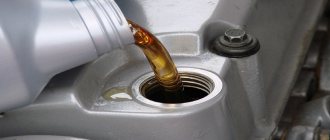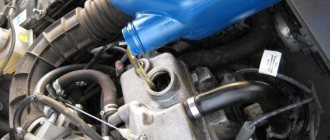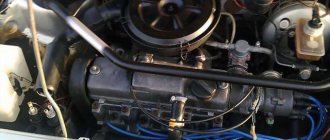The operation of an internal combustion engine requires the use of an anti-wear fluid - motor oil. The service life and power characteristics of the vehicle largely depend on it. Motor oil constantly circulates through the channels of the system, removes heat, and lubricates the mechanisms. Due to this, it is mixed, partially cooled and partially heated. The temperature of the engine oil is constantly changing. What should it be like for the system to work properly? Let's try to figure it out.
Engine oil and engine temperature
Lubricating fluid is an important component for the operation of any engine. The document defining the classification and designation of oils used in internal combustion engines is the interstate standard GOST 17479-85, as amended in 1999. The requirements of this document are interrelated with the international standards SAE, API and ACEA, which determine the parameters of oils depending on the season and ambient temperature. The SAE standard defines the viscosity-temperature characteristics of a lubricant. The API standard specifies the use of lubricant, depending on the type of engine, its production date and technical parameters (for example, with or without turbocharging). The ACEA standard was developed by European manufacturers. It is similar to the API standard, but has more stringent indicators.
Based on these documents, motor oil can be gasoline, diesel and universal. The oil solution is made from mineral oil with the addition of various components and additives. Depending on the additives, the oil fluid in the engine unit is divided into: mineral, synthetic and semi-synthetic.
According to its structure, the oil solution is divided into three types:
- Winter. A special feature is its more liquid state, which makes it easier to start the car. During the warm season, the oil solution is not suitable for use, since during operation its viscosity will become less than the standard. The functions of protecting and lubricating units will be reduced to a minimum. Has alphanumeric markings.
- Summer. Used at ambient temperatures above zero degrees. This liquid has a high viscosity and fluidity. Use in winter is not recommended, as the high viscosity will make starting the vehicle difficult. Has digital markings.
- All-season. The most popular type of fluid among all drivers. Can be used at any time of the year at any ambient temperature. Has double marking.
The choice of oil has a direct impact on engine temperature. The operating temperature of the power plant ranges from 70 to 90 degrees in winter. As the temperature rises to zero, you can start driving when the engine warms up to 50-70 degrees. In summer, components and assemblies do not need to be warmed up. You can start moving in natural conditions. At the recommended temperature conditions, the engine starts and runs reliably, and the cylinders are filled to the maximum extent. Some types of starters have a normal operating mode at temperatures from 100 to 110 degrees. Basically, this is a wound air-cooled unit, for example a two-stroke engine.
Negative phenomena in internal combustion engines due to thermal disturbances
The cause of aging of motor oil is the oxidation processes of hydrocarbon group elements occurring in the oil base. In this case, reaction products are released in the form of various deposits: carbon deposits, varnishes, sludge deposits. Temperature conditions have the greatest influence on this.
Soot is a solid substance in the form of soot, which is a product of the oxidation of hydrocarbons. This also includes unburned fuel elements (iron, lead), as well as various mechanical impurities. Carbon deposits cause all sorts of disruptions to the normal working process (detonation, glow ignition and some others).
Varnish is the result of oxidation of the oil film covering the contacting surfaces under the influence of high temperature in the combustion chamber. Up to 80% of its volume is carbon, the rest is oxygen, hydrogen and ash. The varnish coating impairs heat transfer through the oil film and leads to dangerous overheating of the piston and cylinder. The most dangerous is varnish deposits in the piston grooves, leading to ring sticking due to “coking”. The latter is a symbiosis of soot and varnish film.
Sludge is a mixture of products of low-temperature oxidation of carbon compounds with aqueous and emulsion contaminants. The reasons for their occurrence are: insufficient engine temperature, low oil quality, engine design features, as well as operating mode.
How does the engine lubrication system work?
The task of the lubrication system is to store, transport, clean and supply oil to the rubbing parts of the engine in order to reduce friction of mating parts, ensure a smooth start of the engine and prevent it from overheating. The task is accomplished by a complex of components and assemblies, which includes:
- Engine crankcase (sump) with drain neck.
- Oil pump.
- Oil filter.
- Radiator for cooling oil fluid.
- Pressure reducing valve.
- Pressure meter.
- Temperature sensor.
- Pipelines.
Functionality of lubricating fluids
In order for the power unit to function stably, it is necessary to select the correct lubricant solution. Its selection is made according to parameters, the main of which are:
- Viscosity. The main indicator of any oil. It means the ability of an oil fluid to maintain the proper level of fluidity while covering parts inside the engine. The degree of viscosity depends on the engine temperature and its own. As the temperature rises, the viscosity level drops.
- Viscosity index. A value that determines the level of viscosity of a lubricant solution depending on its temperature. Increasing the viscosity index increases the temperature range in which it can operate. The indicator is different for each type of oil.
- Flash temperature reading. A value that determines the level of low-boiling fractions in the oil liquid. In high-quality oils, flash occurs at temperatures of +230 degrees and above. If the oil solution is of poor quality, then low-viscosity components will quickly burn out and evaporate, and its consumption will increase.
- Boiling temperature reading. An indicator at which an oil fluid loses its viscosity and lubricating properties. Its boiling will lead to contact between the rubbing parts of the power plant and its failure.
- Ignition temperature reading. The amount of critical heating of the oil fluid. Its combustion begins when its temperature reaches +260 degrees. Ignition threatens to cause the engine to explode and cause injury to passengers.
- Volatility. The oil solution begins to evaporate at a temperature of +250 degrees. Determination of volatility is carried out using the NOC method. At the specified temperature, one liter of oil must be boiled for one hour. If after an hour there are 900 grams of liquid left, then the volatility level is 10%. According to international standards, this norm should not exceed 15%.
- Freeze temperature reading. A value that determines the level of loss of fluidity of an oil fluid. When the pour point is reached, the viscosity of the lubricant increases sharply or a process of increasing viscosity occurs with the solidification of paraffin, as a result of which the lubricant hardens.
- Alkaline TVN value. A number that determines the alkaline characteristics of the oil obtained as a result of the addition of detergent and degrading additives. This is an indicator of the ability of an oil fluid to neutralize harmful impurities and acids resulting from the operation of the power plant. A decrease in the alkaline index indicates a decrease in the number of active additives, which can lead to corrosion of the internal parts of the power plant.
- Acid number TAN. An indicator that determines the presence of oxidation elements in the lubricant. An increase in acid number indicates the presence of a large number of oxidation products. The acid number is determined when selecting oil for analysis. Typically, an increased acid value is associated with prolonged operation or high operating temperature of the power plant.
Engine oil operating temperature
The lubricant, depending on its characteristics, can be used in the temperature range from - 50 to + 170 degrees. The operating temperature of the oil in a warm engine and the preservation of its viscosity-technical parameters depend on the temperature regime of the engine. Normal engine temperature ranges from + 80 to + 90 degrees. With such heating, the starting unit has maximum efficiency. Oil lubricant warms up 10-15 degrees more than coolant. Therefore, the operating temperature of engine oil in a warm engine ranges from + 90 to + 105 degrees. It is not recommended to exceed the upper value. This threatens the lubricant with loss of characteristics and rapid wear of rubbing parts.
Determination of viscosity by marking
A branded canister of motor oil from any manufacturer contains detailed information about the viscosity index of the product according to the CAE system. The viscosity designation consists of numerical and alphabetic symbols, for example, 5W40.
Here the English letter W indicates a winter parameter. The numbers to the left and right of it are winter and summer temperature indicators, respectively. This range ensures stable engine operation using a specific product.
Changes in engine oil temperature
Engine parts are designed to expand when heated and return to their original state as the engine cools. The operation of the power unit depends on the temperature of the oil in a running engine. Excessively low or high heating of the oil in a running engine has negative consequences.
The low temperature of the lubricant can be considered + 80 degrees. With this indicator, the efficiency of the power plant decreases and its service life decreases. The parts of the power unit will have a slight expansion, which will lead to the formation of gaps between them and a decrease in compression. When the starter is slightly warmed up, moisture can condense and form acids in the lubricant, which will affect the wear of components and assemblies. Low degrees can cause the lubricant to thicken and freeze. This will affect its passage through the filter, creating a vacuum in the lubrication system and difficulties in the operation of the power plant.
High heat is even more dangerous than low heat. Heating the oil fluid above + 105 degrees leads to its viscosity sharply decreasing and fluidity increasing. Under load, the gap between the parts almost disappears, the parts of the crank mechanism come into contact with each other.
Hydrodynamic and boundary lubrication: what are the differences?
The hydrodynamic process occurs as follows: the oil fluid is pumped through a pump and, passing through a heat exchanger, reaches the crankshaft through the filtration system. These actions are performed under pressure, and if the engine operating temperature is normal, the lubricant travels all the way in a fraction of a second. At the beginning of rotation, a so-called oil wedge is created. It is formed due to the fact that lubricating fluid under strong pressure enters the gap between the crankshaft journals and the bearings.
If the engine is started in the cold season, exactly the same processes occur in it. But due to its high viscosity, the oil cannot pass through the filter. As a result, the lubricating fluid passes through the bypass valve, causing the product to be partially unfiltered. However, this situation does not affect the normal operation of the engine. The design features of the motor ensure the passage of oxol to its parts, even if the filter blocks the flow of liquid. As the temperature rises, the viscosity decreases and the lubricant again begins to pass through the filter system without affecting the bypass valve.
A process called “boundary lubrication” involves constantly renewing the oil. In this case, a liquid containing anti-wear additives is used. This way, all engine parts that the oxol passes through without pressure are lubricated.
The lubricant is renewed by spraying through nozzles or by splashing. New generation engines have special cooling nozzles, which reduces the piston temperature. Boundary lubrication allows you to constantly remove used oil from parts of the mechanism and bring it a new portion.
Viscosity-temperature characteristics
According to interstate standard 17479.1-85, oils are divided according to viscosity, purpose and performance indicators. Based on viscosity, lubricants are divided into winter and summer classes. The class has a numerical designation; the letter “z” is added to the winter class.
According to their intended purpose, oil fluids are divided into groups that determine the operating mode of power units, with appropriate markings:
- Unforced gasoline and diesel engines. Marked with the letter "A".
- Low-powered gasoline and diesel engines. Marked with the letter “B1” - gasoline, “B2” - diesel.
- Medium-boosted gasoline and diesel engines. Marked with the letter “B1” - gasoline, “B2” - diesel.
- Highly accelerated gasoline and diesel engines operating in various conditions. Marked with the letter “G1, D1” - gasoline, “G2, D2” - diesel, “E1, E2”
The oil marking consists of numbers and letters. For example, the marking M-4з/6В1 means: M – oil, 4 – viscosity class, the letter “z” – winter, 6 – viscosity class in summer, B1 – medium-boosted gasoline power unit. The characteristics are the same as SAE 10w/20 oil.
The viscosity-temperature characteristics of oils according to interstate standard 17479.1-85 and the ratio with SAE are presented in the table:
| Viscosity grade in CIS countries | Highest viscosity at -18C | Viscosity parameters at +100С | SAE classification | |
| minimum | maximum | |||
| 3z | 1200 | 3.8 | 5w | |
| 4z | 2500 | 4.1 | 10w | |
| 5z | 6100 | 5.6 | 15w | |
| 6z | 10500 | 20w | ||
| 6 | 7.0 | 20 | ||
| 8 | 7.0 | 9.5 | 20 | |
| 10 | 9.5 | 11.5 | 30 | |
| 12 | 11.5 | 13.0 | 30 | |
| 14 | 13.0 | 15.0 | 40 | |
| 16 | 15.0 | 18.0 | 40 | |
| 20 | 18.0 | 23.0 | 50 | |
| 3z/8 | 1200 | 7.0 | 9.5 | 5w/20 |
| 4z/6 | 2500 | 5.5 | 7.0 | 10w/20 |
| 4z/8 | 7.0 | 9.5 | ||
| 4z/10 | 9.5 | 11.5 | 10w/30 | |
| 5z/10 | 6100 | |||
| 5z/12 | 11.5 | 13.0 | ||
| 5z/14 | 13.0 | 15.0 | 15w/40 | |
| 6z/10 | 10500 | 9.5 | 11.5 | 20w/30 |
| 6z/14 | 13.0 | 15.0 | ||
| 6z/16 | 15.0 | 18.0 | ||











